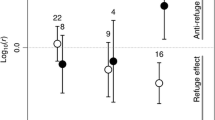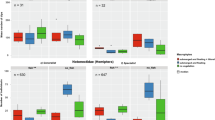Abstract
Species replacements along freshwater permanence gradients are well documented, but underlying mechanisms are poorly understood for most taxa. In subalpine wetlands in Colorado, the relative abundance of caddisfly larvae shifts from temporary to permanent basins. Predators on caddisflies also shift along this gradient; salamanders (Ambystoma tigrinum nebulosum) in permanent ponds are replaced by predaceous diving beetles (Dytiscus dauricus) in temporary habitats. We conducted laboratory and field experiments to determine the effectiveness of caddisfly cases in reducing vulnerability to these predators. We found that larvae of a temporary-habitat caddisfly (Asynarchus nigriculus) were the most vulnerable to salamanders. Two relatively invulnerable species (Limnephilus externus, L. picturatus) exhibited behaviors that reduced the likelihood of detection and attack, whereas the least vulnerable species (Agrypnia deflata) was frequently detected and attacked, but rarely captured because cases provided an effective refuge. Vulnerability to beetle predation was also affected by cases. The stout cases of L. externus larvae frequently deterred beetle larvae, whereas the tubular cases of the other species were relatively ineffective. Two of these vulnerable species (A. nigriculus and L. picturatus) often co-occur with beetles; thus, case construction alone is insufficient to explain patterns of caddisfly coexistence along the permanence gradient. One explanation for the coexistence of these two species with beetles is that they develop rapidly during early summer and pupate before beetle larvae become abundant. One species (L. picturatus) pupates by burying into soft substrates that serve as a refuge. The other (A. nigriculus) builds stone pupal cases, which in field experiments, more than doubles survival compared to organic pupal cases. The combined results of these experiments suggest that caddisfly distributions along permanence gradients depend on a suite of primary and secondary predator defenses that include larval and pupal case structure, predator-specific escape behaviors, and the phenology of larval development.









Similar content being viewed by others
References
Altwegg R (2002) Predator-induced life-history plasticity under time constraints in pool frogs. Ecology 83:2452–2551
Anholt BR, Werner E, Skelly DK (2000) The effects of food and predators on the activity of four larval ranid frogs. Ecology 81:3509–3521
Batzer DP, Wissinger SA (1996) Ecology of insect communities in nontidal wetlands. Annu Rev Entomol 41:75–100
Edmunds M (1974) Defense in animals: a survey of anti-predator defenses. Longman Publishers, London
Formaniwicz DR (1982) Foraging tactics of larvae of Dytiscus verticalis (Coleoptera:Dytiscidae): the assessment of prey density. J Anim Ecol 51:757–767
Galatowitsch M, Mumme RL (2004) Escape behavior of Neotropical homopterans in response to a flush-pursuit predator: the importance of primary defenses. Biotropica 36:586–595
Holomuzki JR (1989) Predatory behavior of larval Ambystoma tigrinum nebulosum on Limnephilus (Trichoptera) larvae. Great Basin Nat 43:475–476
Huryn AD, Wallace JB (2000) Life history and production of stream insects. Ann Rev Entomol 45:83–110
Johansson A (1991) Caddis larvae cases (Trichoptera, Limnephilidae) as anti-predatory devices against brown trout and sculpin. Hydrobiologia 211:185–194
Johansson A, Johansson F (1992) Effects of different caddisfly case structures on predation by dragonfly larva. Aquat Insects 14:73–84
Johansson A., Englund G (1995) A predator–prey game between bullheads and case-making caddis larvae. Anim Behav 50:785–792
Johansson A, Nilsson AN (1992) Dytiscus latissimus and D. circumcinctus (Dytiscidae) larvae as predators on three case-making caddis larvae. Hydrobiologia 248:201–213
Johansson F, Suhling F (2004) Behaviour and growth of dragonfly larvae along a permanent to temporary water habitat gradient. Ecol Entomol 29:196–202
Kriska G, Schmera D (2002) Case building material of Potamophylax rotundipennis (Insecta: Trichoptera) as an anti-predatory device against Dytiscus marginalis (Insecta: Coleoptera) larvae. Hidrológiai Közlöny 82:73–75
Leips J, McManus MG, Travis J (2000) Response of treefrog larvae to drying ponds: comparing temporary and permanent pond breeders. Ecology 81:2997–3008
Matsuda H, Abrams PA, Hori M, (1993) The effect of adaptive anti-predator behavior on exploitative competition and mutualism between predators. Oikos 68:549–559
Matsuda H, Hori M, Abrams PA (1996) Effects of predator-specific defence on biodiversity and community complexity in two-trophic-level communities. Evol Ecol 10:13–28
McPeek MA (1990) Behavioral differences between Enallagma species (Odonata) influencing differential vulnerability to predators. Ecology 71:1714–1726
McPeek MA (1995a) Morphological evolution mediated by behavior in the damselflies of two communities. Evol 49:749–769
McPeek MA (1995b) Testing hypotheses about evolutionary change on single branches of a phylogeny using evolutionary contrasts. Am Nat 145:686–703
McPeek MA (1996) Trade-offs, food web structure, and the co-existence of habitat specialists and generalists. Am Nat 148(suppl):S124–S138
McPeek MA (1999) Biochemical evolution associated with antipredator adaptation in damselflies. Evolution 53:1835–1845
McPeek MA (2000) Predisposed to adapt? clade-level differences in characters affecting swimming performance in damselflies. Evolution 54:2072–2080
McPeek MA, Brown JM (2000) Building a regional species pool: diversification of the Enallagma damselflies in eastern North American waters. Ecology 81:904–920
McPeek MA, Grace M, Richardson JML (2001) Physiological and behavioral responses to predators shape the growth/predation risk trade-off in damselflies. Ecology 82:1535–1545
Nislow KH, Molles MC (1993) The influence of larval case design on vulnerability of Limnephilus frijole (Trichoptera ) to predation. Freshw Biol 29:411–417
Otto C (1976) Habitat relationships in larvae of three Trichoptera species. Archiv für Hydrobiologie 77:505–517
Otto C (1982) Habitat, size, and distribution of Scandinavian limnephilid caddisflies. Oikos 38:355–360
Otto C (2000) Cost and benefit from shield cases in caddis larvae. Hydrobiologia 436:350–400
Otto C, Svensson BS (1980) The significance of case material selection for the survival of caddis larvae. J Anim Ecol 49:855–865
Otto C, Johansson A (1995) Why do some caddis larvae in running waters construct heavy, bulky cases? J Anim Ecol 49:855–865
Peacor SD, Werner E (1997) Trait-mediated indirect interactions in a simple aquatic community. Ecology 1146–1156
Peckarsky BL, Taylor BW, McIntosh AR, McPeek MA, Lytle DA (2001) Variation in mayfly size at metamorphosis as a developmental response to risk of predation. Ecology 82:740–757
Pierce CL (1988) Predator avoidance, microhabitat shift, and risk sensitive foraging in larval dragonflies. Oecologia 77:81–90
Power ME, Marks JC, Parker MS (1992) Variation in the vulnerability of prey to different predators: community-level consequences. Ecology 73:2218–2223
Relyea RA (2000) Trait-mediated indirect effects in larval anurans: reversing competition with the threat of predation. Ecology 81:2278–2289
Relyea RA, Werner EE (1999) Quantifying the relation between predator-induced behavior and growth performance in larval anurans. Ecology 80:2117–2124
Richardson JML (2002) The relative roles of adaptation and phylogeny in determination of larval traits in diversifying anuran lineages. Am Nat 157:282–299
Schneider DW (1999) Snowmelt ponds in Wisconsin: influence of hydroperiod on invertebrate community structure. In: Batzer DP, Rader RR, Wissinger SA (eds) Invertebrates in freshwater wetlands of North America: ecology and management. Wiley, New York, pp 299–318
Schneider DW, Frost TM (1996) Habitat duration and community structure in temporary ponds. J North Am Benth Soc 15:64–86
Skelly DM (1995) A behavioral trade-off and its consequences for the distribution of Pseudacris treefrog larvae. Ecology 76:150–164
Skelly DM (1997) Tadpole communities. Am Sci 85:36–45
Stevens DJ, Hansell MH, Monaghan P (2000) Developmental trade-offs and life histories: strategic allocation of resources in caddisflies. Proc R Acad Lond 267:104:1511–1515
Stoks R, McPeek MA (2003a). Antipredator behavior and digestive physiology determine Lestes species turnover along a gradient. Ecology 84:3327–3328
Stoks R, McPeek MA (2003b) Predators and life histories shape Lestes damselfly assemblages along the freshwater habitat gradient. Ecology 84:1576–1587
Stoks R, McPeek MA, Mitchell JL (2003) The evolution of anti-predator behavior as lineages adapt to different habitats: damselflies in fish and dragonfly lakes. Evol 57:574–585
Wellborn GA (2002) Trade-off between competitive ability and antipredator adaptation in a freshwater amphipod species complex. Ecology 83:129–136
Wellborn GA, Skelly DK, Werner EE (1996) Mechanisms creating community structure across a freshwater habitat gradient. Annu Rev Ecol Syst 27:337–363
Werner EE, Anholt BR (1993) Ecological consequences of the trade-off between growth and mortality rates mediated by foraging activity. Am Nat 142:242–272
Werner EE, Anholt BR (1996) Predator-induced behavioral indirect effects in anuran larvae. Ecology 77:157–169
Werner EE, McPeek MA (1994) The roles of direct and indirect effects on the distributions of two frog species along an environmental gradient. Ecology 75: 1368–1382
Whiteman HH, Wissinger SA, Bohonak A (1994) Seasonal movement patterns and diet in a subalpine population of the tiger salamander, Ambystoma tigrinum nebulosum. Can J Zool 72:1780–1787
Whiteman HH, Wissinger SA (2005) Population cycles and long-term data sets. In: Lanoo M (ed) Conservation status of declining amphibians. University of California Press, Berkeley
Williams DD (1996) Environmental constraints in temporary freshwaters and consequences for the insect fauna. J North Am Benth Soc 15:634–650
Williams DD, Tavares AF, Bryant E (1987) Respiratory device or camouflage? A case for the caddisfly. Oikos 50:42–52
Wissinger SA (1999). Ecology of wetland invertebrates: synthesis and applications for conservation and management. In: Batzer DP, Rader RB, Wissinger SA (eds) Invertebrates in freshwater wetlands of North America: ecology and management. Wiley, New York, pp 1043–1086
Wissinger SA, Sparks GB, Rouse GL, Brown WS, Steltzer H (1996) Intraguild predation and cannibalism among larvae of detritivorous caddisflies in subalpine wetlands. Ecology 77:2421–2430
Wissinger SA, Gallagher LJ (1999) Beaver pond wetlands in western Pennsylvania: modes of colonization and succession after drought. In: Batzer DP, Rader RB, Wissinger SA (eds) Invertebrates in freshwater wetlands of North America: ecology and management. Wiley, New York, pp 333–362
Wissinger SA, Sparks GB, Rouse GB, Brown WS (1999a) Tradeoffs between competitive superiority and vulnerability to predation in caddisflies along a permanence gradient in subalpine wetlands. Ecology 80:2102–2116
Wissinger SA, Bohonak AJ, Whiteman HH, Brown WS (1999b) Subalpine wetlands in central Colorado: habitat permanence, salamander predation, and invertebrate communities. In: Batzer DP, Rader RB, Wissinger SA (eds) Invertebrates in freshwater wetlands of North America: ecology and management. Wiley, New York, pp 757–790
Wissinger SA, Brown WS, Jannot JE (2003) Caddisfly life histories along permanence gradients in high-elevation wetlands in Colorado (USA). Freshw Biol 48:255–270
Wissinger SA, Steinmetz J, Alexander JS, Brown WS (2004a) Larval cannibalism, time constraints, and adult fitness in caddisflies that inhabit temporary wetlands. Oecologia 138:39–47
Wissinger SA, Eldermire C, Whissel JC (2004b) The role of larval cases in reducing aggression and cannibalism among caddisflies in temporary wetlands. Wetlands 24:777–783
Zamora-Munoz C, Svensson BW (1996) Survival of caddis larvae in relation to their case material in a group of temporary and permanent pools. Freshw Biol 36:23–31
Acknowledgements
We are grateful to the Rocky Mountain Biological Laboratory and The Nature Conservancy for access to the Mexican Cut Nature Reserve. We thank Miranda Mumford for the drawings in Fig. 2. Comments by Jason Jannot, Mark Galatowitsch, Lindsey Shouey, Hamish Greig, Angus McIntosh, Jay Rosenheim, and two anonymous reviewers greatly improved an earlier version of this paper. This work was funded by grants to S. Wissinger from the National Science Foundation (DEB- 9407856 and DEB-010893).
Author information
Authors and Affiliations
Corresponding author
Additional information
Communicated by Jay Rosenheim
Rights and permissions
About this article
Cite this article
Wissinger, S.A., Whissel, J.C., Eldermire, C. et al. Predator defense along a permanence gradient: roles of case structure, behavior, and developmental phenology in caddisflies. Oecologia 147, 667–678 (2006). https://doi.org/10.1007/s00442-005-0303-1
Received:
Accepted:
Published:
Issue Date:
DOI: https://doi.org/10.1007/s00442-005-0303-1




